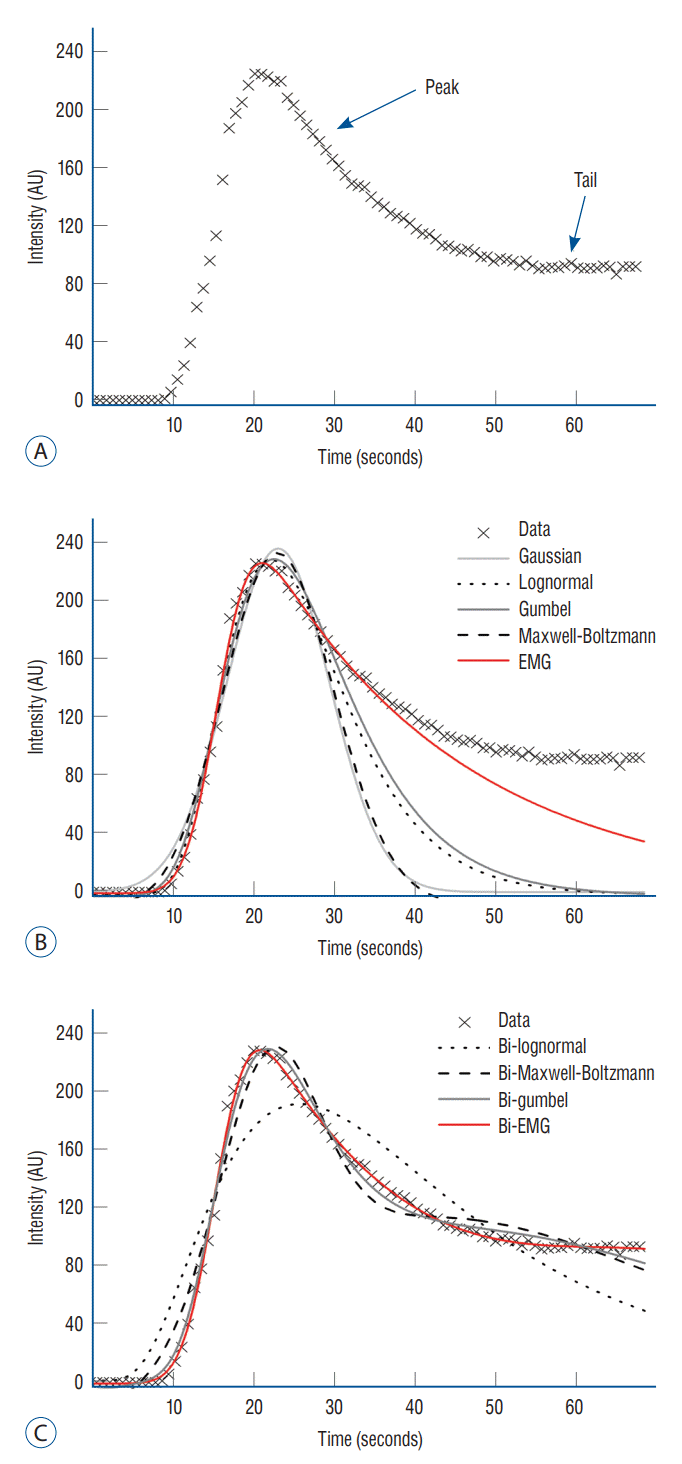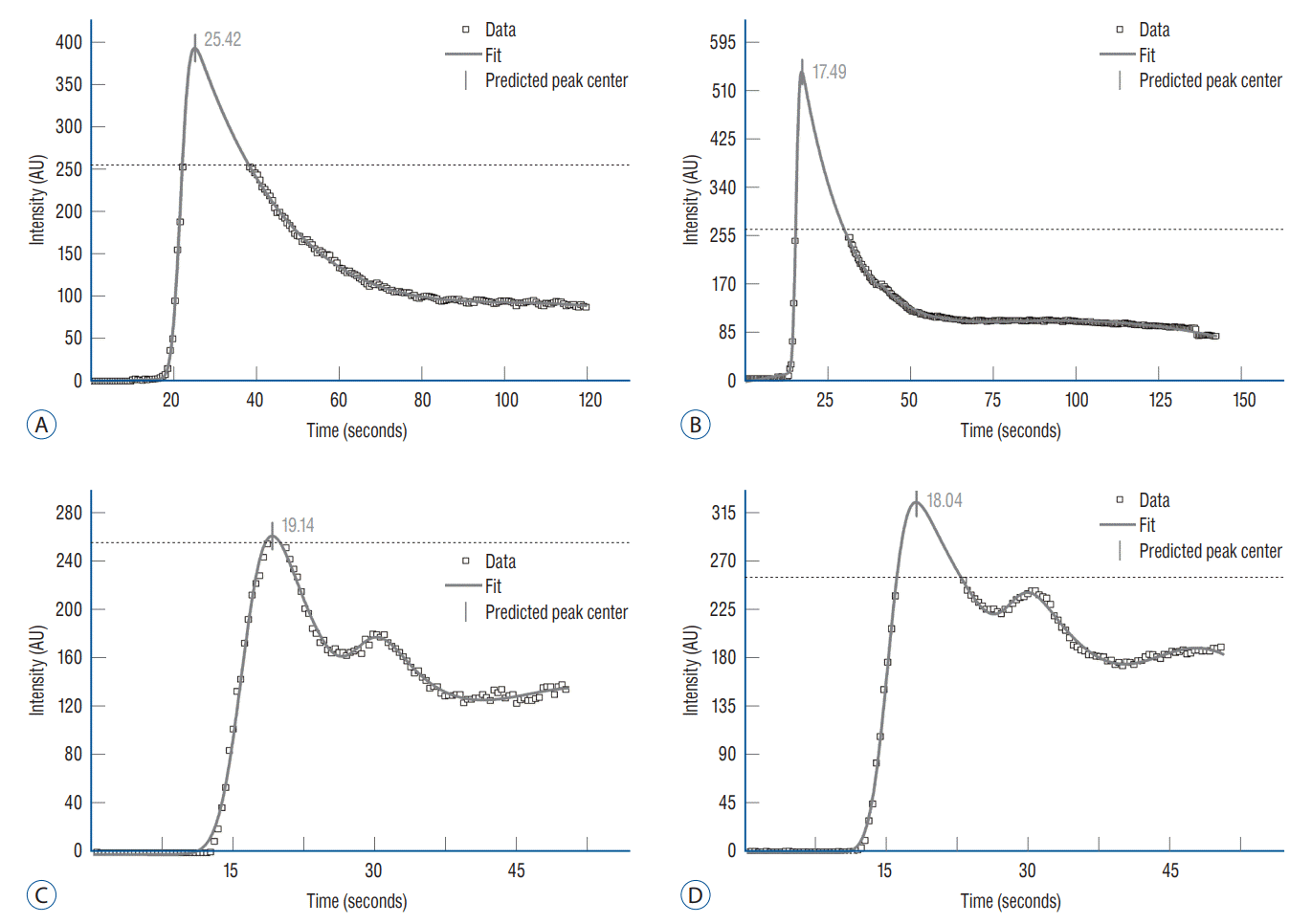1. Awano T, Sakatani K, Yokose N, Kondo Y, Igarashi T, Hoshino T, et al. Intraoperative EC-IC bypass blood flow assessment with indocyanine green angiography in moyamoya and non-moyamoya ischemic stroke. World Neurosurg. 73:668–674. 2010.

2. Bagher-Ebadian H, Nejad-Davarani SP, Paudyal R, Nagaraga TN, Brown S, Knight R, et al. Construction of a model-based high resolution arterial input function (AIF) using a standard radiological AIF and the Levenberg-Marquardt algorithm. Proc Intl Soc Mag Reson Med. 19:3902. 2011.
3. Calamante F, Thomas DL, Pell GS, Wiersma J, Turner R. Measuring cerebral blood flow using magnetic resonance imaging techniques. J Cereb Blood Flow Metab. 19:701–735. 1999.

4. Chen SF, Kato Y, Oda J, Kumar A, Watabe T, Imizu S, et al. The application of intraoperative near-infrared indocyanine green videoangiography and analysis of fluorescence intensity in cerebrovascular surgery. Surg Neurol Int. 2:42. 2011.

5. Dashti R, Laakso A, Niemelä M, Porras M, Hernesniemi J. Microscope-integrated near-infrared indocyanine green videoangiography during surgery of intracranial aneurysms: the helsinki experience. Surg Neurol. 71:543–550. discussion 550. 2009.

6. de Oliveira JG, Beck J, Seifert V, Teixeira MJ, Raabe A. Assessment of flow in perforating arteries during intracranial aneurysm surgery using intraoperative near-infrared indocyanine green videoangiography. Neurosurgery. 62(6 Suppl 3):1300–1310. 2008.

7. Ferroli P, Acerbi F, Tringali G, Albanese E, Broggi M, Franzini A, et al. Venous sacrifice in neurosurgery: new insights from venous indocyanine green videoangiography. J Neurosurg. 115:18–23. 2011.

8. Foley JP, Dorsey JG. A review of the exponentially modified gaussian (EMG) function: evaluation and subsequent calculation of universal data. J Chromatogr Sci. 22:40–46. 1984.

9. Foster SG, Embree PM, O’Brien WR. Flow velocity profile via time-domain correlation: error analysis and computer simulation. IEEE Trans Ultrason Ferroelectr Freq Control. 37:164–175. 1990.

10. Gelisken F, Inhoffen W, Schneider U, Stroman GA, Kreissig I. Indocyanine green videoangiography of occult choroidal neovascularization: a comparison of scanning laser ophthalmoscope with high-resolution digital fundus camera. Retina. 18:37–43. 1998.

11. Golubev A. Exponentially modified gaussian (EMG) relevance to distributions related to cell proliferation and differentiation. J Theor Biol. 262:257–266. 2010.

12. Grushka E. Characterization of exponentially modified gaussian peaks in chromatography. Anal Chem. 44:1733–1738. 1972.

13. Hänggi D, Etminan N, Steiger HJ. The impact of microscope-integrated intraoperative near-infrared indocyanine green videoangiography on surgery of arteriovenous malformations and dural arteriovenous fistulae. Neurosurgery. 67:1094–1103. discussion 1103-1104. 2010.

14. Iida H, Kanno I, Miura S, Murakami M, Takahashi K, Uemura K. Error analysis of a quantitative cerebral blood flow measurement using H2(15) O autoradiography and positron emission tomography, with respect to the dispersion of the input function. J Cereb Blood Flow Metab. 6:536–545. 1986.

15. Jerosch-Herold M, Swingen C, Seethamraju RT. Myocardial blood flow quantification with MRI by model-independent deconvolution. Med Phys. 29:886–897. 2002.

16. Kalambet Y, Kozmin Y, Mikhailova K, Nagaev I, Tikhonov P. Reconstruction of chromatographic peaks using the exponentially modified gaussian function. J Chemom. 25:352–356. 2011.

17. Kety SS, Schmidt CF. The nitrous oxide method for the quantitative determination of cerebral blood flow in man: theory, procedure and normal values. J Clin Invest. 27:476–483. 1948.

18. Kim K, Isu T, Chiba Y, Morimoto D, Ohtsubo S, Kusano M, et al. The usefulness of icg video angiography in the surgical treatment of superior cluneal nerve entrapment neuropathy: technical note. J Neurosurg Spine. 19:624–628. 2013.

19. Kobayashi S, Ishikawa T, Tanabe J, Moroi J, Suzuki A. Quantitative cerebral perfusion assessment using microscope-integrated analysis of intraoperative indocyanine green fluorescence angiography versus positron emission tomography in superficial temporal artery to middle cerebral artery anastomosis. Surg Neurol Int. 5:135. 2014.

20. Koeppe RA, Holden JE, Ip WR. Performance comparison of parameter estimation techniques for the quantitation of local cerebral blood flow by dynamic positron computed tomography. J Cereb Blood Flow Metab. 5:224–234. 1985.

21. Ku DN. Blood flow in arteries. Ann Rev Fluid Mech. 29:399–434. 1997.

22. Lee JJ, Powers WJ, Faulkner CB, Boyle PJ, Derdeyn CP. The kety-schmidt technique for quantitative perfusion and oxygen metabolism measurements in the mr imaging environment. AJNR Am J Neuroradiol. 34:E100–E102. 2013.

23. Li X, McGuffin VL. Theoretical evaluation of methods for extracting retention factors and kinetic rate constants in liquid chromatography. J Chromatogr A. 1203:67–80. 2008.
24. Lin W, Celik A, Derdeyn C, An H, Lee Y, Videen T, et al. Quantitative measurements of cerebral blood flow in patients with unilateral carotid artery occlusion: a pet and mr study. J Magn Reson Imaging. 14:659–667. 2001.

25. Motulsky H, Christopoulos A. Fitting models to biological data using linear and nonlinear regression : a practical guide to curve fitting. Oxford: Oxford University Press;2004.
26. Motulsky HJ, Ransnas LA. Fitting curves to data using nonlinear regression: a practical and nonmathematical review. FASEB J. 1:365–374. 1987.

27. Oda J, Kato Y, Chen SF, Sodhiya P, Watabe T, Imizu S, et al. Intraoperative near-infrared indocyanine green-videoangiography (ICG-VA) and graphic analysis of fluorescence intensity in cerebral aneurysm surgery. J Clin Neurosci. 18:1097–1100. 2011.

28. Olufsen MS, Nadim A, Lipsitz LA. Dynamics of cerebral blood flow regulation explained using a lumped parameter model. Am J Physiol Regul Integr Comp Physiol. 282:R611–R622. 2002.
29. Raabe A, Beck J, Gerlach R, Zimmermann M, Seifert V. Near-infrared indocyanine green video angiography: a new method for intraoperative assessment of vascular flow. Neurosurgery. 52:132–139. discussion 139. 2003.

30. Sbalzarini IF. Modeling and simulation of biological systems from image data. Bioessays. 35:482–490. 2013.

31. Schuette AJ, Cawley CM, Barrow DL. Indocyanine green videoangiography in the management of dural arteriovenous fistulae. Neurosurgery. 67:658–662. discussion 662. 2010.

32. Shah KJ, Cohen-Gadol AA. The application of flow 800 ICG videoangiography color maps for neurovascular surgery and intraoperative decision making. World Neurosurg. 122:e186–e197. 2019.

33. Son YJ, Kim JE, Park SB, Lee SH, Chung YS, Yang HJ. Quantitative analysis of intraoperative indocyanine green video angiography in aneurysm surgery. J Cerebrovasc Endovasc Neurosurg. 15:76–84. 2013.

34. van der Geest RJ, de Roos A, van der Wall EE, Reiber JH. Quantitative analysis of cardiovascular mr images. Int J Card Imaging. 13:247–258. 1997.
35. Wintermark M, Maeder P, Thiran JP, Schnyder P, Meuli R. Quantitative assessment of regional cerebral blood flows by perfusion CT studies at low injection rates: a critical review of the underlying theoretical models. Eur Radiol. 11:1220–1230. 2001.

36. Wintermark M, Reichhart M, Thiran JP, Maeder P, Chalaron M, Schnyder P, et al. Prognostic accuracy of cerebral blood flow measurement by perfusion computed tomography, at the time of emergency room admission, in acute stroke patients. Ann Neurol. 51:417–432. 2002.











 PDF
PDF Citation
Citation Print
Print



 XML Download
XML Download